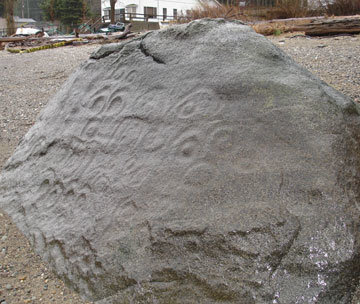Easter Island has its stone statues. England has its Stonehenge. Key Peninsula has its petroglyph.
 A mysterious petroglyph is located on private property on a Key Peninsula beach. Photo by Frank Slater
A mysterious petroglyph is located on private property on a Key Peninsula beach. Photo by Frank Slater
A silent, ageless sentinel stands its eternal vigil along the shores of the Key Peninsula. Was it created by the enigmatic Kennewick Man during his travels 9,200 years ago? By our earliest human ancestors who first crossed the Bering Straight land bridge from Asia 17,000 years ago? Or by a bored young Indian teenager “tagging” a rock with stone-carved graffiti?
What purpose does our “Rock Guard” serve? Is it merely “rock art” with no real function except aesthetics? Or is it a monument to some ancient battle or long dead warrior chief? Or a tribute to the gods, a boundary line, or a declaration of “no trespassing”? Or did aliens from Alpha Centari stop by for a picnic a million years ago and use their laser guns to mark “Kilroy was here”?
Few answers are available. Even age is indeterminate, as rock cannot be carbon dated.
There are two main repositories of archaeological information in Washington state: the Burke Museum in Seattle, which is managed by the University of Washington, and the office of the state archaeologist in Olympia. “The Burke” maintains records and studies done by UW archaeologists. State law requires that all archaeological studies and reports for all objects of archaeological interest in the state must be forwarded and maintained by the state archaeologist.
The KP petroglyph is indexed as object No. MS49. Indians did not have a written language, so historical reference had to wait until the arrival of white explorers and settlers. The earliest reference found for this petroglyph dates to 1909.
A 1948 report by John Winterhouse described the petroglyph as being “a large boulder, 8 feet, 5 inches long and 5 feet high.” Winterhouse’s report documented “an attempt to remove the boulder to Tacoma for display but its size and weight had prevented it.” Dr. Robert Grengo, professor emeritus from UW, discussed this incident further in a 1963 survey done by the university.
Daniel Leen published “Rock Art of Western Washington” in Northwest Anthropological Research Notes in 1981, which briefly discusses our glyph. Grengo followed with a book, “Prehistoric Places on Southern NW Coast” in 1983.
Despite numerous professional studies, little is known about the KP petroglyph. Leen states in his report there is “no known ethnographic information referring to it,” but elsewhere he attributes all of the rock art in Western Washington to Salish (a collective term referring to the various Indian tribes in the region). Petroglyphs, created by carving, incising or abrading rock, are believed to have originated in prehistoric times. They have been found all over the world.
Leen identifies 18 Salish rock art sites in Western Washington, 17 of which are petroglyphs. Laura Phillips, an archaeologist at The Burke, says, “There are four rock art sites in Pierce County.”
Leen describes the carvings in the Key Peninsula petroglyph as depicting “11 faces, seven pairs of eyes, eight circles, two pits, one rake (possibly a quadruped), one face with arms attached and a line issuing from the mouth, and two undecipherable designs.” Leen further writes, “This site is the largest single group of petroglyphs in Puget Sound. Because it is typical of other sites in the area in both style and content, it may be regarded as the typeset for southern Puget Sound rock art.”
State law now makes it a criminal act to damage or move “items of archaeological interest,” and it is illegal to trespass on private property. The location of this petroglyph has not been revealed to remove temptation, and to protect the object and property rights.
Mysteries still surround us. Answers still await discovery. Meanwhile, our “Rock Guard” still performs its duty, whatever that duty may be.
UNDERWRITTEN BY THE FUND FOR NONPROFIT NEWS (NEWSMATCH) AT THE MIAMI FOUNDATION, THE ANGEL GUILD, ADVERTISERS, DONORS AND PEOPLE WHO SUPPORT INDEPENDENT, NONPROFIT LOCAL NEWS